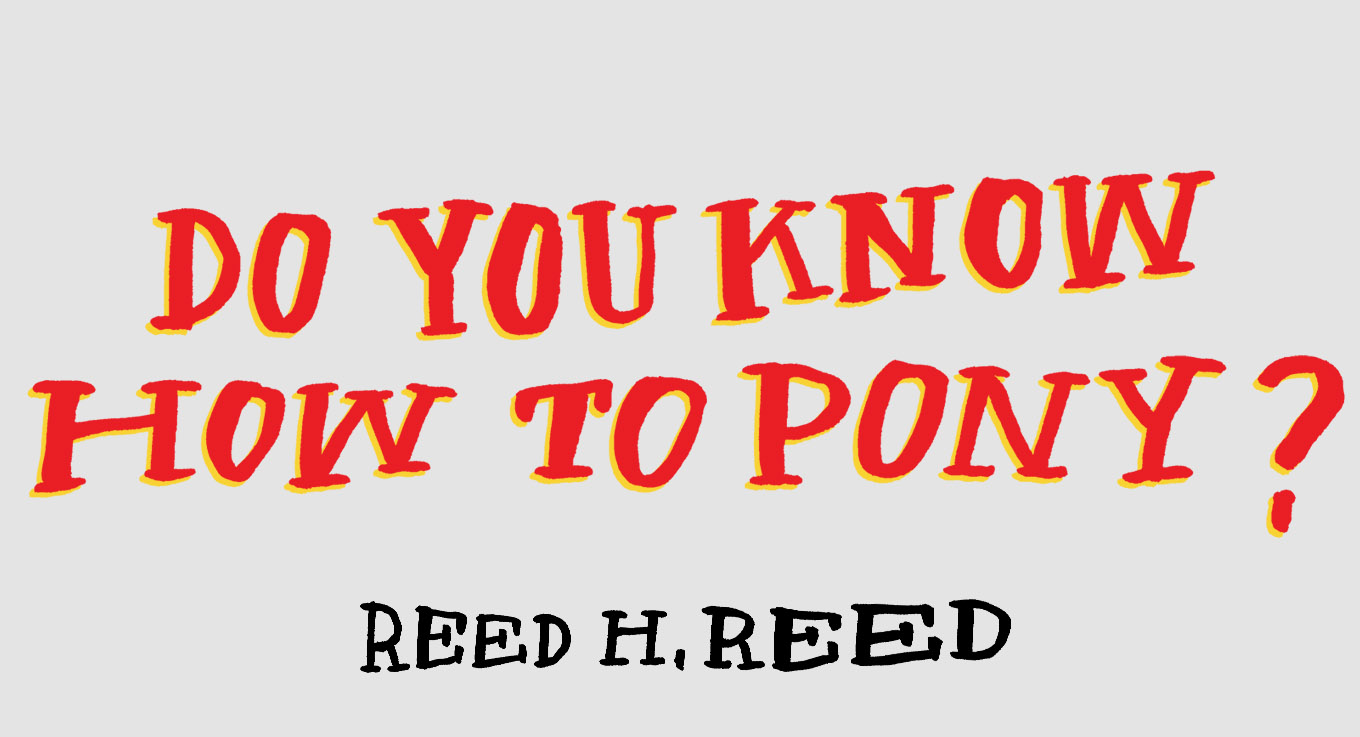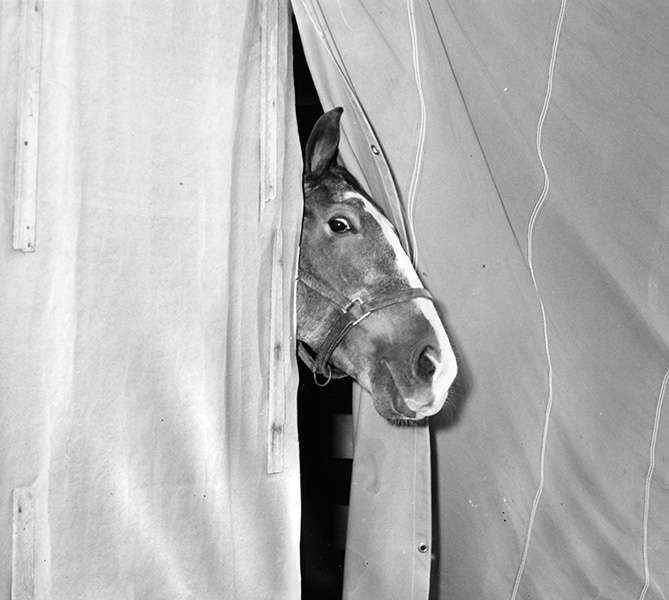



Fat Brain Toys have a product called “Clip Cloppers,” which are short plastic stilts in a concave shape for “accurate hoofbeat sound.” Clip clop clip clop. A catre-corner rhythm, first one front leg, then a back leg, then a front, then a back, sometimes with the hoof lazily trailing along the ground.
In Finland, a 16-year-old girl achieves the incredible physical feat of jumping 4 feet, 7 inches high on a hobby horse, a stuffed horse head attached to a wooden pole. “Does your horse have a name?” inquires an incredulous talk show host, after having a good laugh at a video of other hobby horsing teen girls practicing walks, trots, and canters. “Of course he has a name,” she shortly retorts. Somewhere between the age of 10 and 16, embodying animal movements have gone from wholesome and educational to immature and perverse. “A horse is a thought,” doodles the hobby horser in a lined notebook and I know exactly what she means.
My heart, like the collective hearts of many other rural-adjacent preteen girls, was captured by the idea of “horse-ness.” It started with collecting books, horse care manuals, and riding magazines. I would make drawings, perfecting the angles from the hoof to the fetlock to the hock. I had figurines in plastic and porcelain, and models that I would paint based on different breed characteristics. My favorite breed was the Caspian—little, delicate grey horses with a kind and willing temperament. Though, I’ve never met one.
When I was 14 years old I brokered a deal with a local stable in Ladner to look after some horses in exchange for riding, which I pretended to enjoy. I preferred being in the horses’ big, gentle presence, picking the dirt out of their hooves, walking them out to pasture, feeding them, sitting on the wood shavings in their stalls and watching their tails swish flies away. Around this time, the tiny elastics around my dental braces were the same size and colours as the elastics that I used for show grooming. Alternating purple and green between incisor and molar matching rotating elastics on button braids from a horse’s head all the way down her neck to her withers.
Monthly, the farrier would reverse her pickup truck into the barn and swing out her mobile forge. Her name was Heather and she looked like Lyle Lovett. She had muscular forearms and hands, with a few choice burns; some fresh and red, others in various states of healing. I watched as she expertly pushed the side of her body into the horse, ran her hand down the inside of her front leg and pulled a little at the bottom. The horse would always obligingly lift her leg, which Heather then wedged tight between her thighs while she filed off the length of the hoof. “She’s a dyke,” the stable manager once said to me, “but she’s a good farrier.”
Identification with animals can be a very queer thing. If you don’t see yourself reflected in your peer group or within your family, perhaps you can feel some affinity with a snail that goes dormant for hot summer months, a raven that holds a grudge for a lifetime, or the very subtle movements of the ears, eyes, and mouth that a horse uses to communicate.
I once met a teenage girl who felt that she had the spirit of a horse inside of her human form. She was part of a much larger network of therians; humans who identify (at least partially) as animals. Her after-school crew of other-than-humans included a cat, a wolf, and a bear, and some who were fluid between animals. They would meet in the forest to playfight, howl, and run, and also to articulate together what it meant to feel non-human in their memories, sensations, and desires.
City living isn’t compatible with extreme horsiness, really. So, we substitute dogs. My dog and I go for long walks most days. At two years old, she’s an adolescent. She’s trying some new behaviours—barking at the bearded, chasing joggers, and eagerly rolling in very, very stinky things. Last night’s walk involved three smells—a decomposing rat, riverbank sludge, and a white, creamy, mystery jizz, which I never found the source of. She was carried from the car straight to the bath, and scrubbed clean. I was bored enough and curious enough to google “why do dogs roll in stinky stuff.” There are lots of theories—the main one being that they try to mask their own scent with other pungent smells, so that they can hunt more effectively. Makes sense.
On a fringe psychology blog, I found an unverified theory that I like a bit more; dogs roll in smells as a form of self-expression. Just like a person may put on a cologne or a particularly loud and expressive shirt, dogs find an opportunity in aroma to differentiate, to stand apart from the pack. This is something that I find deeply relatable, that a mode of self-expression can be repellant to a broader community. Hobby horsers, animal-identified teens, adolescent dogs, and dykes experiencing an ill-fit between external expectations and personal desire doesn’t stop us. Because, maybe it’s the context that’s the problem.
Reed H. Reed is an artist who makes texts, objects, editions, and public projects. They live between Vancouver, BC on Musqueam, Squamish, and Tsleil-Waututh territories, and Dawson City, YT on the traditional territories of the Tr’ondëk Hwëch’in, where they teach foundation visual arts at Yukon School of Visual Arts. Reed’s work has appeared at the Portland Art Museum (OR), Dunlop Art Gallery (SK), Art League (TX), Dalhousie University Art Gallery (NS), Vancouver Art Gallery (BC), The Power Plant (ON), and Flat Time House’s first issue of noit (UK). Reed frequently collaborates with their partner, Hannah Jickling.


Fat Brain Toys have a product called “Clip Cloppers,” which are short plastic stilts in a concave shape for “accurate hoofbeat sound.” Clip clop clip clop. A catre-corner rhythm, first one front leg, then a back leg, then a front, then a back, sometimes with the hoof lazily trailing along the ground.
In Finland, a 16-year-old girl achieves the incredible physical feat of jumping 4 feet, 7 inches high on a hobby horse, a stuffed horse head attached to a wooden pole. “Does your horse have a name?” inquires an incredulous talk show host, after having a good laugh at a video of other hobby horsing teen girls practicing walks, trots, and canters. “Of course he has a name,” she shortly retorts. Somewhere between the age of 10 and 16, embodying animal movements have gone from wholesome and educational to immature and perverse. “A horse is a thought,” doodles the hobby horser in a lined notebook and I know exactly what she means.
My heart, like the collective hearts of many other rural-adjacent preteen girls, was captured by the idea of “horse-ness.” It started with collecting books, horse care manuals, and riding magazines. I would make drawings, perfecting the angles from the hoof to the fetlock to the hock. I had figurines in plastic and porcelain, and models that I would paint based on different breed characteristics. My favorite breed was the Caspian—little, delicate grey horses with a kind and willing temperament. Though, I’ve never met one.
When I was 14 years old I brokered a deal with a local stable in Ladner to look after some horses in exchange for riding, which I pretended to enjoy. I preferred being in the horses’ big, gentle presence, picking the dirt out of their hooves, walking them out to pasture, feeding them, sitting on the wood shavings in their stalls and watching their tails swish flies away. Around this time, the tiny elastics around my dental braces were the same size and colours as the elastics that I used for show grooming. Alternating purple and green between incisor and molar matching rotating elastics on button braids from a horse’s head all the way down her neck to her withers.
Monthly, the farrier would reverse her pickup truck into the barn and swing out her mobile forge. Her name was Heather and she looked like Lyle Lovett. She had muscular forearms and hands, with a few choice burns; some fresh and red, others in various states of healing. I watched as she expertly pushed the side of her body into the horse, ran her hand down the inside of her front leg and pulled a little at the bottom. The horse would always obligingly lift her leg, which Heather then wedged tight between her thighs while she filed off the length of the hoof. “She’s a dyke,” the stable manager once said to me, “but she’s a good farrier.”
Identification with animals can be a very queer thing. If you don’t see yourself reflected in your peer group or within your family, perhaps you can feel some affinity with a snail that goes dormant for hot summer months, a raven that holds a grudge for a lifetime, or the very subtle movements of the ears, eyes, and mouth that a horse uses to communicate.
I once met a teenage girl who felt that she had the spirit of a horse inside of her human form. She was part of a much larger network of therians; humans who identify (at least partially) as animals. Her after-school crew of other-than-humans included a cat, a wolf, and a bear, and some who were fluid between animals. They would meet in the forest to playfight, howl, and run, and also to articulate together what it meant to feel non-human in their memories, sensations, and desires.
City living isn’t compatible with extreme horsiness, really. So, we substitute dogs. My dog and I go for long walks most days. At two years old, she’s an adolescent. She’s trying some new behaviours—barking at the bearded, chasing joggers, and eagerly rolling in very, very stinky things. Last night’s walk involved three smells—a decomposing rat, riverbank sludge, and a white, creamy, mystery jizz, which I never found the source of. She was carried from the car straight to the bath, and scrubbed clean. I was bored enough and curious enough to google “why do dogs roll in stinky stuff.” There are lots of theories—the main one being that they try to mask their own scent with other pungent smells, so that they can hunt more effectively. Makes sense.
On a fringe psychology blog, I found an unverified theory that I like a bit more; dogs roll in smells as a form of self-expression. Just like a person may put on a cologne or a particularly loud and expressive shirt, dogs find an opportunity in aroma to differentiate, to stand apart from the pack. This is something that I find deeply relatable, that a mode of self-expression can be repellant to a broader community. Hobby horsers, animal-identified teens, adolescent dogs, and dykes
experiencing an ill-fit between external expectations and personal desire doesn’t stop us. Because, maybe it’s the context that’s the problem.

Reed H. Reed is an artist who makes texts, objects, editions, and public projects. They live between Vancouver, BC on Musqueam, Squamish, and Tsleil-Waututh territories, and Dawson City, YT on the traditional territories of the Tr’ondëk Hwëch’in, where they teach foundation visual arts at Yukon School of Visual Arts. Reed’s work has appeared at the Portland Art Museum (OR), Dunlop Art Gallery (SK), Art League (TX), Dalhousie University Art Gallery (NS), Vancouver Art Gallery (BC), The Power Plant (ON), and Flat Time House’s first issue of noit (UK). Reed frequently collaborates with their partner, Hannah Jickling.